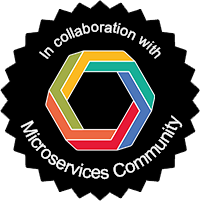Keynotes
Keynote - Rip It Up And Start Again
Sam Newman @ Sam Newman & Associates
June 14th, 2021, 15:05–16:30 CEST
Abstract
Much of the attention for microservice architectures tends to focus on the technical aspects. But when you look into the details of organisations that have benefited from this approach you realise that there is more to getting the most out of microservices than lots of shinny new technology.
In this talk, Sam will show how organisational structures and team responsibilities may need to change if you want to get the most out of adopting a microservice architecture. Looking at traditional IT structures and comparing them with the modern autonomous delivery teams, he’ll explore how to get the organisation and architecture working well together. From Conway’s law to Dunbar’s number, stream-aligned to two pizza teams, you’ll see how you can start to apply these ideas inside your own company.
Speaker's Bio
 After spending time at multiple startups and 12 years at ThoughtWorks, Sam
Newman is now an independent consultant. Specializing in microservices,
cloud, and continuous delivery, Sam helps clients deliver software faster
and more reliably through training and consulting. An experienced speaker,
Sam has given talks at conferences across the world and is the author of
Monolith to Microservices, and the forthcoming Building Microservices, 2nd
edition, both from O'Reilly.
After spending time at multiple startups and 12 years at ThoughtWorks, Sam
Newman is now an independent consultant. Specializing in microservices,
cloud, and continuous delivery, Sam helps clients deliver software faster
and more reliably through training and consulting. An experienced speaker,
Sam has given talks at conferences across the world and is the author of
Monolith to Microservices, and the forthcoming Building Microservices, 2nd
edition, both from O'Reilly.
Keynote - Evolving Monoliths to Microservices
Joseph Yoder & Paulo Merson @ respectively, The Refactory & Brazilian Federal Court of Accounts (TCU)
June 14th, 2021, 19:00–19:45 CEST
Abstract
Many Microservices architectures start from the evolution of a Monolith system by gradually applying the microservices architectural style. There are considerations and principles that assist with successfully evolving from a monolith to Microservices. Deciding what to decouple along with when and how to incrementally evolve a system are the main architectural challenges in this process. There are good principles that help with this evolutionary process. For example, it is important to commit to “stop adding to the monolith” - all new code is added as microservices. The new features are microservices, occasionally replacing part of the monolith. Also, there might be important pieces of the monolith that are getting hard to maintain and you want to pull these out. When this happens, you find design seams within the monolith, which can be refactored out to components that can ultimately be replaced with microservices. This is the core of the “Strangler Pattern”. Beyond the strangling of a monolith, there are other considerations for organizations that make the strategic move to microservices, such as operational readiness and technical skills. Early on, it is ok to create macro services first and then evolve (refactor) them to microservices. Also, when writing new microservices code, it is important to avoid dependencies to the monolith. This talk will examine various scenarios when evolving from the monolith to microservices specifically with variations of the Strangler Pattern.
Speaker Bios
 Joseph (Joe) Yoder (agilist, computer scientist, speaker, and pattern
author) is the founder and principal of The Refactory (www.refactory.com),
a company focused on software architecture, design, implementation,
consulting, and mentoring on all facets of software development. Joe is
also the president of The Hillside Group, a non-profit dedicated to
improving the quality of life of everyone who uses, builds, and
encounters software systems. Joe has presented many tutorials and talks,
arranged workshops, given keynotes, and helped organize leading
international agile and technical conferences. He is best known as an
author of the Big Ball of Mud pattern, which illuminates many fallacies
in software architecture. Joe teaches and mentors developers on Agile
and lean practices, architecture, building flexible systems, clean
design, patterns, refactoring, and testing. Recently Joe has been
working with organizations and thought leaders on the best practices
for including quality aspects throughout the complete software
life-cycle. Joe was recently a co-author of "A Scrum Book: The Spirit of
the Game" which includes 96 patterns for getting the most out of Scrum.
Currently he is working on a book for Cloud Adoption Patterns with some
colleagues. Joe thinks software is still too hard to change and wants to
do something about this. He believes using good practices (patterns),
putting the ability to change software into the hands of the people with
the knowledge to change it, and bringing the business side closer to the
development process helps solve this problem.
Joseph (Joe) Yoder (agilist, computer scientist, speaker, and pattern
author) is the founder and principal of The Refactory (www.refactory.com),
a company focused on software architecture, design, implementation,
consulting, and mentoring on all facets of software development. Joe is
also the president of The Hillside Group, a non-profit dedicated to
improving the quality of life of everyone who uses, builds, and
encounters software systems. Joe has presented many tutorials and talks,
arranged workshops, given keynotes, and helped organize leading
international agile and technical conferences. He is best known as an
author of the Big Ball of Mud pattern, which illuminates many fallacies
in software architecture. Joe teaches and mentors developers on Agile
and lean practices, architecture, building flexible systems, clean
design, patterns, refactoring, and testing. Recently Joe has been
working with organizations and thought leaders on the best practices
for including quality aspects throughout the complete software
life-cycle. Joe was recently a co-author of "A Scrum Book: The Spirit of
the Game" which includes 96 patterns for getting the most out of Scrum.
Currently he is working on a book for Cloud Adoption Patterns with some
colleagues. Joe thinks software is still too hard to change and wants to
do something about this. He believes using good practices (patterns),
putting the ability to change software into the hands of the people with
the knowledge to change it, and bringing the business side closer to the
development process helps solve this problem.
 Paulo Merson has been programming in the small and programming in the
large for over 30 years. He is a developer at the Brazilian Federal
Court of Accounts (TCU). He is also a Visiting Scientist with the
Software Engineering Institute (SEI), adjunct faculty in the Masters of
Software Engineering program at Carnegie Mellon University, and a
faculty member of the master program in Applied Computing at University
of Brasilia. Paulo often delivers professional training to fellow
developers in the US, Latin America, and Europe. His speaking experience
also includes tutorials at DDD Europe, OOP, JavaOne, SPLASH/OOPSLA, SD
Best Practices, SATURN, Dr. Dobb’s Architecture & Design World, lectures
to graduate students in different universities, and invited talks at
different companies. He is co-author of Documenting Software
Architectures: Views and Beyond, 2nd edition. Paulo holds a Bachelor of
Science in Computer Science from University of Brasilia and a Master of
Software Engineering from Carnegie Mellon University.
Paulo Merson has been programming in the small and programming in the
large for over 30 years. He is a developer at the Brazilian Federal
Court of Accounts (TCU). He is also a Visiting Scientist with the
Software Engineering Institute (SEI), adjunct faculty in the Masters of
Software Engineering program at Carnegie Mellon University, and a
faculty member of the master program in Applied Computing at University
of Brasilia. Paulo often delivers professional training to fellow
developers in the US, Latin America, and Europe. His speaking experience
also includes tutorials at DDD Europe, OOP, JavaOne, SPLASH/OOPSLA, SD
Best Practices, SATURN, Dr. Dobb’s Architecture & Design World, lectures
to graduate students in different universities, and invited talks at
different companies. He is co-author of Documenting Software
Architectures: Views and Beyond, 2nd edition. Paulo holds a Bachelor of
Science in Computer Science from University of Brasilia and a Master of
Software Engineering from Carnegie Mellon University.

